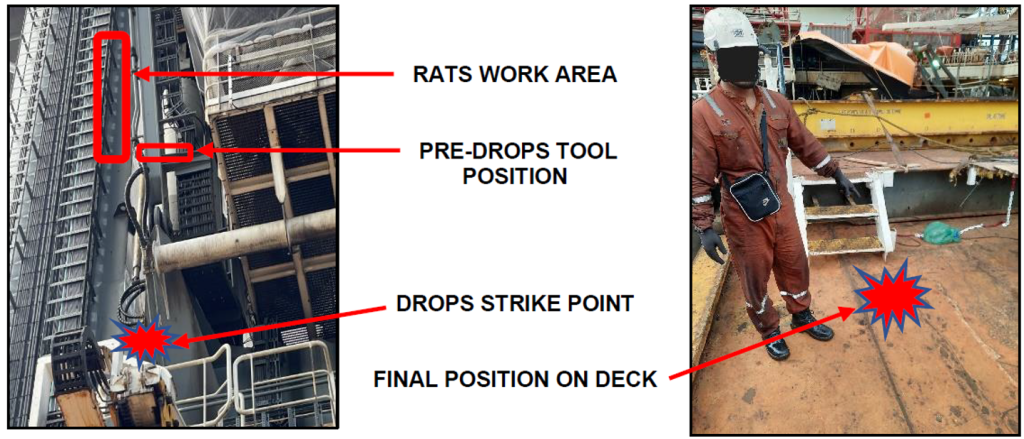Dropped spanner falls 15m
What happened
During work at height, a spanner became disconnected from its DROPS protection lanyard whilst crew were working in an area outside the installed protective netting. The spanner then fell to deck 15 metres below.

Protective netting had been installed for general maintenance on a pipelay system, which would be carried out by crew members and a third-party Rope Access Team. During work on hydraulic hose replacement, a member of the third-party Rope Access Team observed two hoses outside the netting protected area and proceeded to replace them. A spanner (60mm x 1.65 kg) was used, secured to the team member by a 1.2m DROPS prevention tooling lanyard, connected by threaded carabiners at both ends. During the replacement the carabiner threads became loose allowing the carabiner to open. The spanner fell 15 metres to the deck area below which was partially barriered off. No-one was injured. However, workers were nearby on deck.
What went wrong – investigation findings
- The third-party Rope Access Team identified additional hydraulic hoses to replace which were outside the area protected by the netting. This additional work was not authorised, and they claimed to be unaware of the received instructions to only work within the perimeter protected by the netting;
- The third-party Rope Access Team recognized that they may have neglected to secure the carabiner correctly. They reported that the spanner fell from the tower structure and when load was placed on the lanyard recoiled upwards causing the carabiner to disconnect and fall;
- It was noted that because there is no swivel in the wire lanyard, there was a risk of the carabiner opening if the carabiner thread was open. The carabiner threads were also found to be heavily worn and contaminated which compromised the locking mechanism. The pre-work inspection failed to identify the equipment conditions. The DROPS tool kits were not covered within the planned maintenance system;
- People were also observed crossing the barriers below the activity. This was not stopped nor reported to the supervisor. In addition, there had been insufficient assessment of the overall DROPS cone to account for the DROPS path or deflection.
Our member took the following actions
- Ensured all work teams were aware of the scope and limit of work activities and knew to not go beyond those limits without review from management;
- Ensured completion of pre-task inspection of tools/accessories for Working at Height;
- Subjected all Working at Height tools to regular inspection, maintenance and replaced defective parts as required;
- Considered barriers appropriate to the specific nature of the task – taking into account the DROPS cone;
- Properly manage barriers to ensure they are suitably positioned for the work, with sign-off to confirm purpose.
Members may wish to review:
- Dropped object: Failure of lump hammer
- Focus on third-party dropped objects
- Two serious dropped object near miss
Also the following videos:
- HSSE 039 Technip DROPS
- HSSE 042Saipem DROPS – choice not chance
- HSSE 043 Subsea 7 DROPS
Safety Event
Published: 20 April 2023
Download: IMCA SF 10/23
IMCA Safety Flashes
Submit a Report
IMCA Safety Flashes summarise key safety matters and incidents, allowing lessons to be more easily learnt for the benefit of all. The effectiveness of the IMCA Safety Flash system depends on Members sharing information and so avoiding repeat incidents. Please consider adding [email protected] to your internal distribution list for safety alerts or manually submitting information on incidents you consider may be relevant. All information is anonymised or sanitised, as appropriate.
IMCA’s store terms and conditions (https://www.imca-int.com/legal-notices/terms/) apply to all downloads from IMCA’s website, including this document.
IMCA makes every effort to ensure the accuracy and reliability of the data contained in the documents it publishes, but IMCA shall not be liable for any guidance and/or recommendation and/or statement herein contained. The information contained in this document does not fulfil or replace any individual’s or Member's legal, regulatory or other duties or obligations in respect of their operations. Individuals and Members remain solely responsible for the safe, lawful and proper conduct of their operations.
